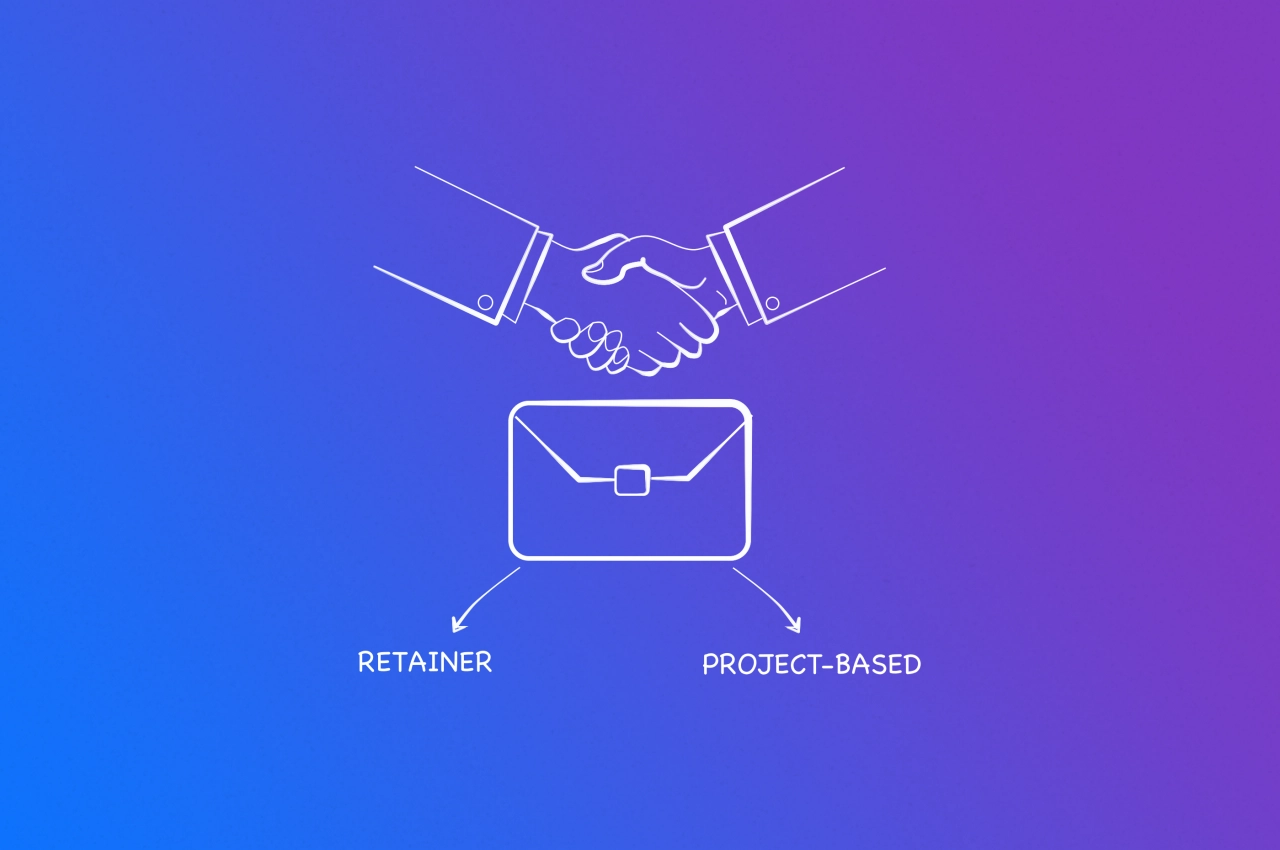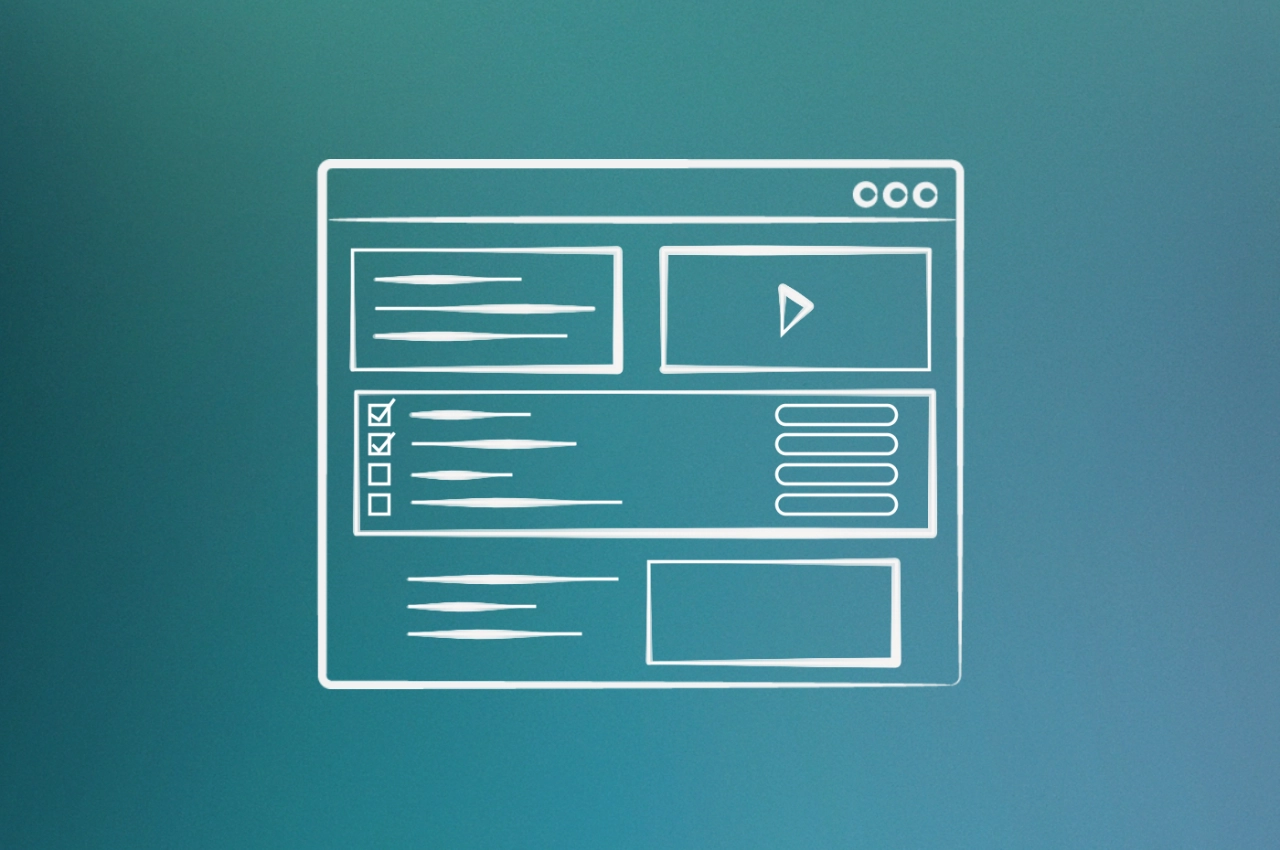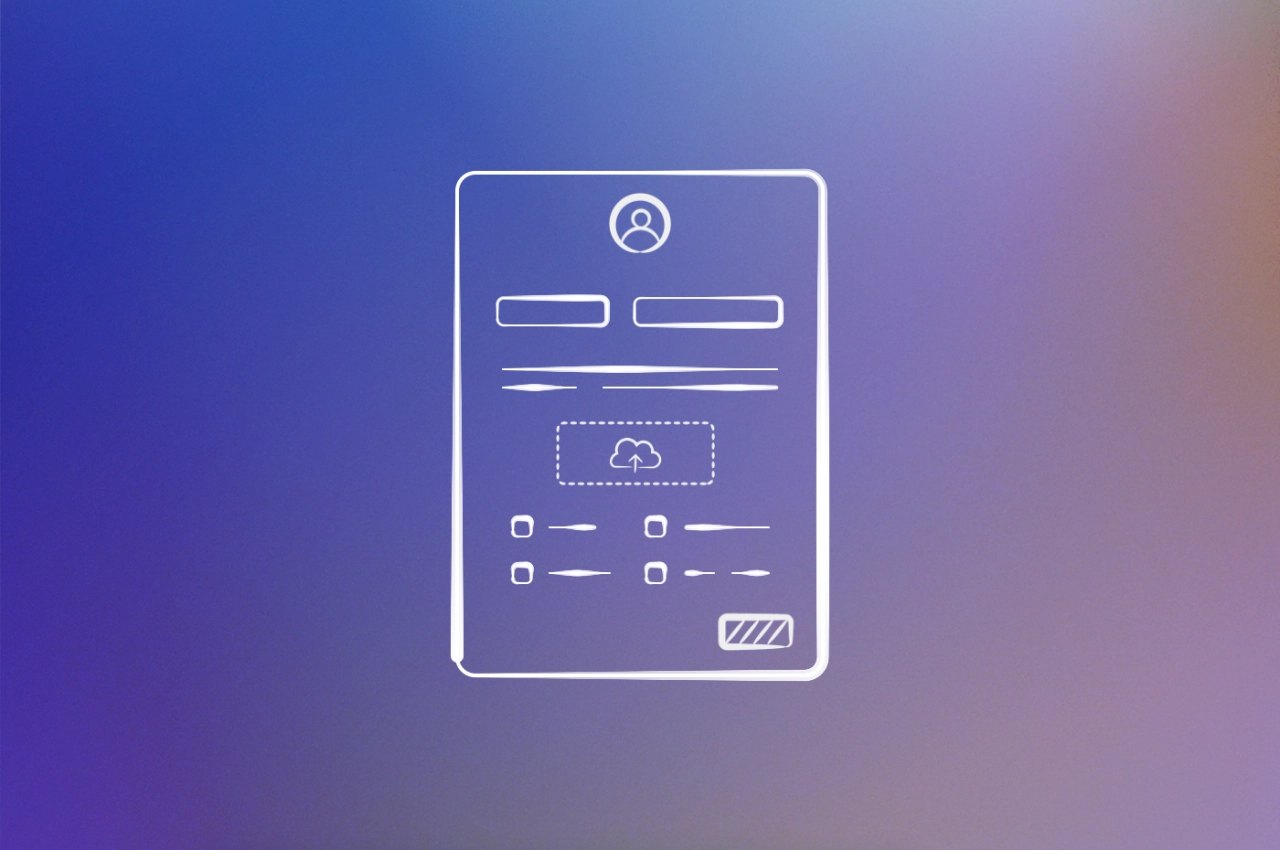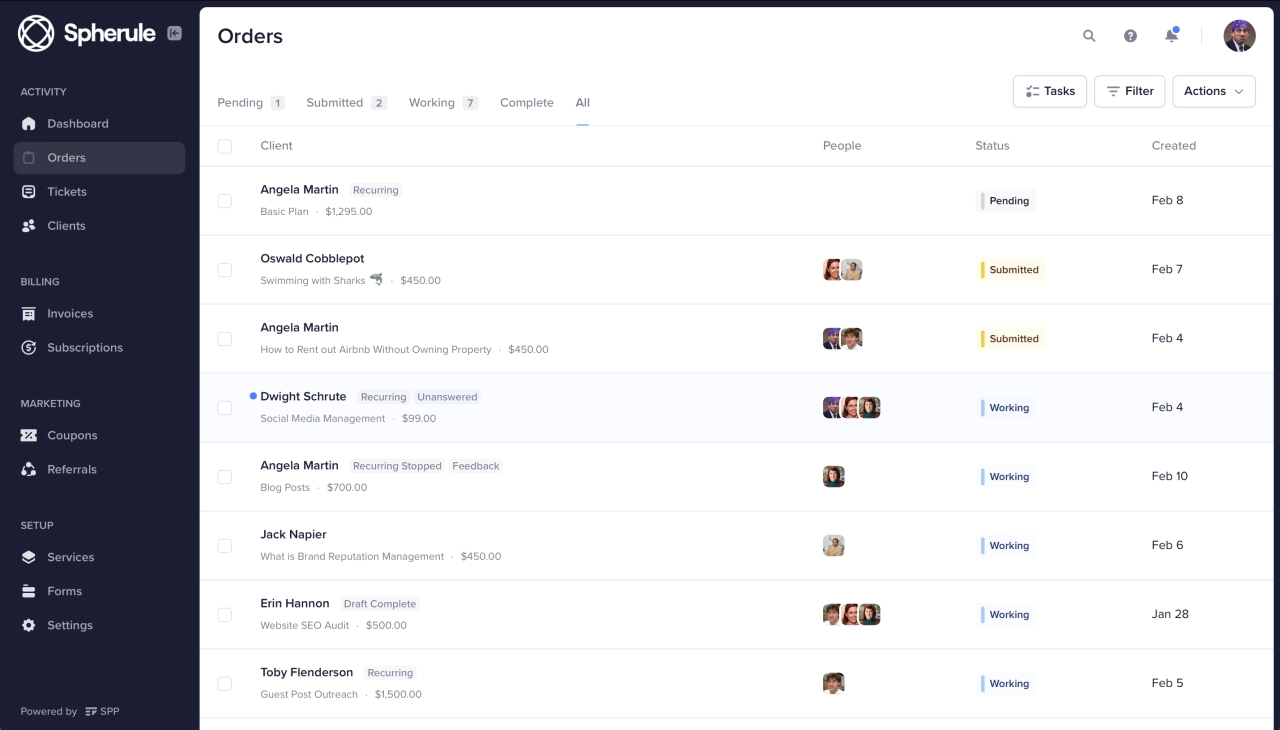- An onboarding questionnaire helps agencies create a positive first impression by showing that they value their opinion and care about their business goals.
- There are different types of onboarding questionnaires depending on services offered:, for example, marketing, SEO, website design, or social media.
- When choosing a questionnaire tool, consider factors such as automation, auto-saving feature, customization options, integration capabilities, and data security.
Can you recall your last visit to a restaurant? The waiter handed you a menu and asked for your order. The reason is simple: Knowing your preferences guarantees a memorable dining experience.
The same principle applies to client onboarding. Understanding your client’s unique needs from the outset enables you to deliver exceptional service tailored specifically to them. A well-crafted client onboarding questionnaire is the secret to achieving this. It streamlines the onboarding process, enhances client experience, and sets the stage for a successful business relationship.
In this article, I’ll explore client onboarding questions you can ask. I’ll also share best practices to consider when choosing a questionnaire tool for your agency.
What is a client onboarding questionnaire?
An onboarding questionnaire is a document agencies use to gather essential information about new clients. It allows you to gain insights into their needs, preferences, challenges, goals, and any specific requirements they might have. With this information, you can create a strategy that aligns with their business objectives and drive measurable results.
A typical questionnaire form contains questions about:
client’s contact information
goals and objectives
challenges
target audience
competitors
project scope and requirements
budget and resources
communication preferences
It’s up to you if you ask all of this within the onboarding form, or if you create a separate branding questionnaire to not overwhelm your new client.
5 reasons to create a client onboarding questionnaire
A questionnaire is no longer optional for agencies; it has become crucial to an effective new client onboarding process. So, if you’re still on the fence about creating one, here are five compelling reasons you should.
1. Create a positive first impression
According to Visa’s How to boost your customer’s onboarding experience, 70% of customers are at risk of abandoning a digital onboarding process if the process takes more than 20 minutes. While this study relates to the banking industry, agencies are at a similar risk if their onboarding forms are too lengthy.
This begs the question: how can agencies improve their onboarding process?
One way to build a good relationship with clients is by using a questionnaire. Asking the right questions about your new client’s business establishes trust and shows you value their opinion.
2. Set clear expectations

Before kickstarting any project, you should clarify what clients can expect from your agency and vice versa. An onboarding questionnaire helps with this. By clearly defining project goals, deliverables, and timelines, both parties can manage expectations, prevent potential misunderstandings, and foster a smooth collaboration.
3. Save time
Constantly reaching out to clients midway through a project is unprofessional and may cause unnecessary delays. However, a questionnaire allows you to collect all necessary information in one go. This proactive approach saves time, increases efficiency, and reduces back-and-forth with clients.
4. Ability to automate

Gathering client information via emails and phone calls is time-consuming, error-prone, and inefficient. But with an onboarding questionnaire, you can automate the customer onboarding, ensuring all relevant information is accurate, accessible, and well-organized. Also, it allows your team to focus on other high-value tasks that drive business growth.
5. Avoid scope creep
Some clients may want to expand a project beyond the initial agreement. A well-crafted questionnaire form comes in handy here. Defining the project deliverables upfront prevents scope creep and allows you to manage additional requests, keeping the project on track and within budget.
Types of onboarding questionnaires
There’s no one-size-fits-all onboarding questionnaire. The questions to ask will vary depending on your agency’s services and client needs. With that said, let’s look at different types of onboarding questionnaires based on some common services.
New client onboarding questionnaire
Working with a new client requires quite a bit of adjustment on the agency’s side as everyone has different expectations. This is where the client questionnaire comes in: it sets expectations and ensures that the client relationship is off to a good start.
Content client onboarding questionnaire
Content agencies require detailed information about their clients in order to craft compelling blog posts, email copy, or landing pages. While they gather project related information in an intake form, the onboarding form is still needed to get a better overview of the client’s goals.
The job of an content agency is not only to put themselves in the shoes of their customer, but to replicate their brand voice. Here’s what an industry expert recommends in order to be successful:
When the questions are overly broad, clients end up giving vague answers that don’t really help shape the brand identity. For example, asking, “What do you want people to think about your brand?” is too open-ended, and clients may struggle to provide actionable feedback. A better approach would be asking them to describe their ideal customer’s journey or the specific pain points their product or service solves.
 James Parsons,
Content Powered
James Parsons,
Content Powered
Marketing client onboarding questionnaire
Behind every successful marketing campaign lies an effective strategy. Developing one requires understanding your client’s current marketing efforts, goals, target audience, and budget.
That’s the job of a marketing onboarding questionnaire—a detailed list of questions a marketing agency provides to new clients. The information helps you create tailored marketing plans that resonate with your client’s needs and expectations.
SEO client onboarding questionnaire
SEO agencies aim to help clients improve their online visibility and drive quality website traffic. To make their job easier, they have to understand their current SEO efforts.
An SEO onboarding questionnaire lets you gather important details such as target keywords, website structure, content strategy, and SEO reporting tools. This equips you with enough information to develop a tailor-made SEO strategy that improves the website’s search engine rankings.
When it comes to writing out the questions, here’s what an SEO expert recommends:
First, avoid overwhelming clients with lengthy forms—I've found that 10–15 targeted questions yield better responses than 50 generic ones. Second, don’t skip questions about competitors—I always include specific questions about 3–5 direct competitors to understand market positioning. Third, make sure to include questions about failed marketing attempts—when I started asking about past failures, we reduced campaign misalignment by 40%.
 Maurizio Petrone,
PressHERO
Maurizio Petrone,
PressHERO
Website design client onboarding questionnaire
Visually appealing websites don’t just spring up out of the blue. They are the product of strategic planning that considers the client’s goal, style guide, target audience, and desired user experience.
You can gather all this crucial information with a website customer onboarding questionnaire. It ensures you understand your client’s business and design requirements before building their website. The result? A seamless and collaborative web development process.
I once worked with a fitness brand struggling to define their identity. Instead of asking about their services or competition, I asked: “If your brand were a song, what would it sound like? How would your audience feel listening to it?” Their answer is: uplifted and unstoppable, like a high-energy anthem. This shaped everything from their tone of voice to visual design. By translating feelings into actionable insights, we created a brand that resonated deeply with their audience.
 Nicholas Robb,
Design Hero
Nicholas Robb,
Design Hero
Social media client onboarding questionnaire
Unlike SEO, social media results are often more immediate and visible. So, you need to craft a solid social media strategy that works. This is where the social media onboarding questionnaire comes in. SMM agencies send it to their clients to learn more about their business goals, current social media presence, ideal target audience, preferred platforms, content themes, and desired outcomes.
The data empowers your agency to develop a tailored social media marketing plan that drives measurable results such as more followers, increased engagement, and qualified leads.
Things to keep in mind when choosing a questionnaire tool
An onboarding questionnaire tool enhances the information-gathering process. But with several options available, how do you know what to choose? Here are some important factors to consider when selecting a questionnaire tool.
1. Allows for automation
The essence of using a questionnaire tool to collect information is to save time, improve accuracy, and increase efficiency. Manually processing it defeats the purpose. Therefore, choose a tool that supports automation. Such software can handle repetitive tasks such as sending reminders, processing responses, and updating records.
2. Auto-saving feature
Imagine filling out a form when an unexpected interruption occurs, forcing you to abandon your progress and start again. This experience discourages clients from completing the form. A customer onboarding questionnaire with an auto-saving feature solves this problem by saving clients’ responses in real-time, ensuring they can continue without losing progress.
3. Doesn’t require email communication
Onboarding questionnaire tools with alternative communication methods, such as in-app messaging or direct link sharing, enhance the information-gathering process for you and your clients.
4. Simple to use
A user-friendly questionnaire tool with an intuitive interface, simple navigation, and easy form creation and editing capabilities will encourage clients to complete the questionnaire.
5. Customization options
Customizing your questionnaire helps create a more personalized and professional experience for clients. Therefore, an onboarding tool should contain design elements that match your agency’s brand identity, enabling you to create custom forms for different clients.
6. Integration capabilities
Another vital feature when selecting your software to build the questionnaire is its integration capability with your existing software, such as agency CRM system, email marketing platforms, and project management tools. It streamlines data collection, reduces manual work, and minimizes errors.
7. Data security
Data privacy and security are paramount in today’s digital world. You don’t want your new client’s information falling into the wrong hands. Therefore, ensure the questionnaire tool complies with relevant data protection regulations and has robust security measures to protect sensitive client information.
Creating an onboarding questionnaire with SPP
At this point, you should be ready to create a questionnaire for effective onboarding of your clients. Service Provider Pro has a tool specifically built for this purpose, we call it the onboarding form builder.
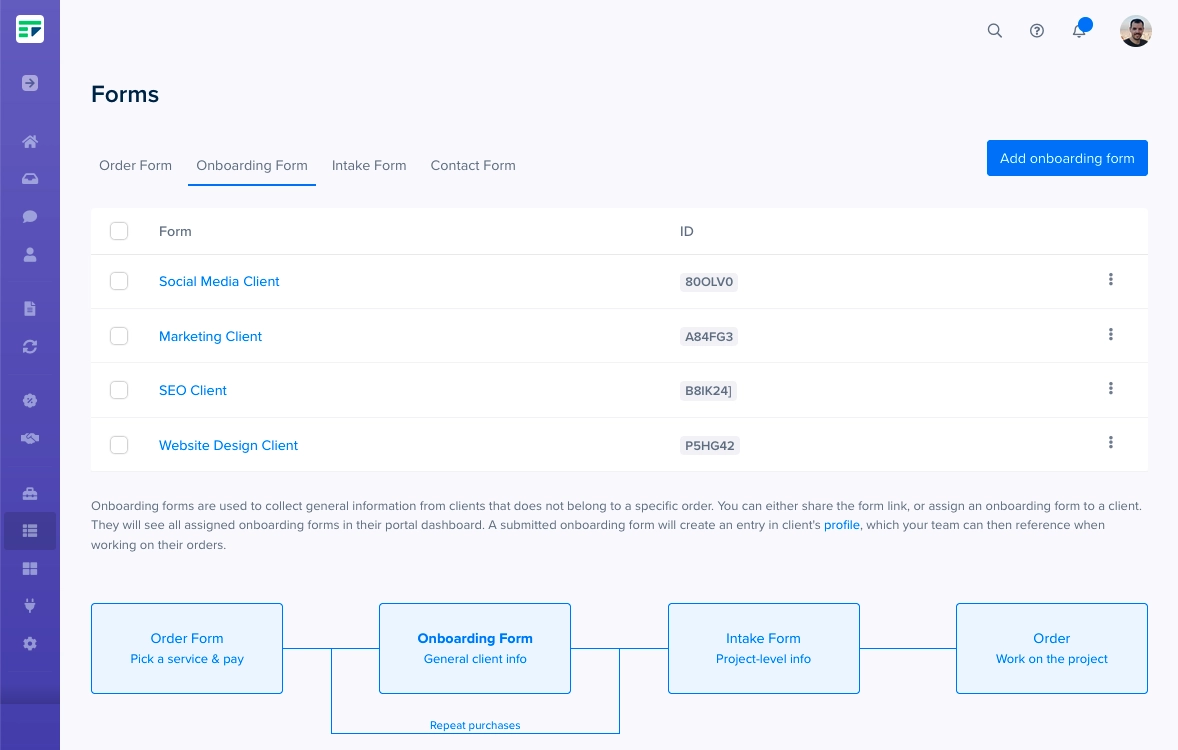
In SPP’s flow, the onboarding forms sit right between the order forms (used for purchases) and intake forms (for project specific information). It’s a great way to get static information from your clients without interrupting the purchase flow, but you also wouldn’t ask these questions in the intake form because they are static, such as information about the client’s brand, tone of voice, etc.
To build your first onboarding form, go to Forms → Onboarding Form and click on the button to add a new form. You can use the building blocks on the right-hand side to create the form. You can choose between dropdowns, option groups, file uploads, and many more field elements.
Once you’re done, save the form, and view it. Test the form you’ve created, and see if there’s anything missing that your client should provide.
Client onboarding questionnaire FAQ
What is an onboarding questionnaire?
An onboarding questionnaire is a comprehensive set of questions agencies use to collect essential information from new clients. The aim is to understand their needs, preferences, goals, and challenges, ensuring a successful business partnership.
How do you onboard a new client in an agency?
You can onboard new clients using a questionnaire to understand their needs, challenges, and preferences. Schedule a meeting to discuss goals and expectations. Then, establish communication channels, assign a team, and provide a project timeline.
How do I make a client onboarding questionnaire?
To create onboarding questionnaires, you can use tools like questionnaire templates, Google Forms, or SPP’s client onboarding form builder. Once clients complete the form, their information is stored on the onboarding portal or in an external CRM.
Use effective agency client onboarding questionnaires
Clients who engage your agency want to see results as soon as possible. A customer onboarding questionnaire fast-tracks this. It’s an excellent tool that helps you understand your client’s needs, goals, and challenges. It allows you to set and manage expectations and lay the foundation for a successful client-agency relationship.
In addition, using a questionnaire tool like SPP’s client onboarding form to automate the process increases speed, accuracy, and efficiency.

